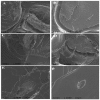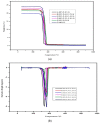Plasticizer Enhancement on the Miscibility and Thermomechanical Properties of Polylactic Acid-Chitin-Starch Composites
- PMID: 31948030
- PMCID: PMC7022536
- DOI: 10.3390/polym12010115
Plasticizer Enhancement on the Miscibility and Thermomechanical Properties of Polylactic Acid-Chitin-Starch Composites
Abstract
In previous research, a polylactic chitin starch composite was prepared without the use of a solvent to enhance the miscibility. In this study, a polylactic acid (PLA) chitin starch composite was produced with chloroform as a plasticizer in the ratio 1:10. The blending of chitin and starch with PLA ranges from 2% to 8%. Tensile strength, impact, thermogravimetry analysis-Fourier-transform infrared spectroscopy (TGA)-FTIR, and differential scanning calorimetry (DSC) were used to test the thermomechanical properties. Also, the morphological properties, water absorption, and wear rate of the material was observed. The results showed that the tensile strength, yield strength, and impact strength were improved compared to the pure polylactic acid. Also, the elastic modulus of the samples increased, but were lower compared to that of the pure polylactic acid. The result of the fractured surface morphology showed good miscibility of the blending, which accounted for the good mechanical properties recorded in the study. The thermogravimetric analysis (TGA) and derivative thermogravimetric analysis DTA show a single degradation and peak respectively, which is also shown in the glass temperature measures from the DSC analysis. The water absorption test shows that the water absorption rate increases with starch content and the wear rate recorded sample A (92% P/8% C) as the highest. The high miscibility projected was achieved with no void, with the use of chloroform as a plasticizer.
Keywords: biopolymer; composite; extrusion; miscibility.
Conflict of interest statement
The authors declare no conflict of interest.
Figures








References
-
- Vince J., Hardesty B.D. Plastic pollution challenges in marine and coastal environments: From local to global governance. Restor. Ecol. 2016;25:123–128. doi: 10.1111/rec.12388. - DOI
-
- Marine Plastic Waste Solution Research Objectives. Association of Commonwealth Universities Early Research Fellowship Report. [(accessed on 15 October 2018)]; Available online: https://www.acu.ac.uk/news/view?id=274.
LinkOut - more resources
Full Text Sources

